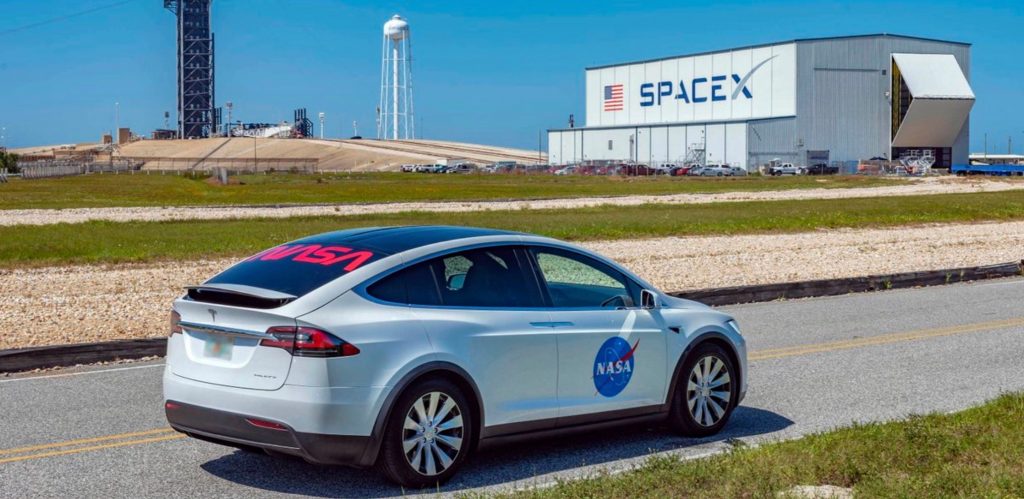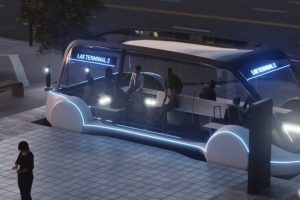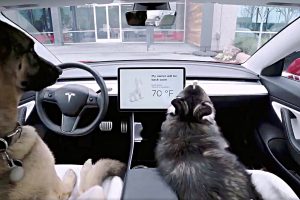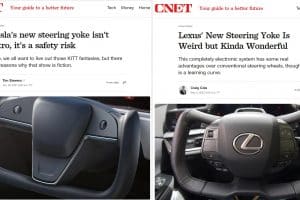One of the exciting things coming up for Tesla is the Roadster’s SpaceX package. With the rear seats deleted and replaced by a high-pressure air tank, cold gas thrusters will be able to help propel the vehicle from 0-60 in 1.1 seconds, and may also enable the car to fly in “short hops” at some point. By adding space technology and parts to a car, Tesla can do great things.
What most people don’t know is that SpaceX also buys car parts from Tesla for rockets. Behind this collaboration is one of SpaceX’s key strengths that sets it apart from the rest of the corrupt space industry.
The Collaborations We Already Knew Of
In some ways, the Tesla/SpaceX collaboration is not new information.

One high-profile thing is SpaceX’s use of the Tesla Model X to take astronauts to the launchpad for a ride to space on the Falcon 9 in the Crew Dragon. Instead of using the ancient Astronaut Transfer Van, a Tesla Model X is used to take them from the Operations and Checkout Building to the launch pad, which is several miles away. When one company run by Elon Musk gets something from the other company, real money does change hands, and the public portions of the companies’ records will reflect these large transactions.
We know that some key personnel are also shared between the companies. Elon Musk is obviously the most prominent example, but there’s also both companies’ vice president of materials engineering, Charles Kuehmann. The shared materials engineering leader explains at least in part why the Cybertruck and the Starship both use stainless steel.
Tesla Is Building Parts For Space
The thing that we didn’t know was that Tesla supplies more than just vehicles and expertise. It also sell parts for SpaceX’s rockets. More than $2 million worth of vehicle components were bought from Tesla for non-automotive use. $100,000 was spent buying “engineering support and resources,” and $700,000 was spent buying a custom tool for SpaceX to use building rockets.
What exactly these things are, we don’t know, but we do know that they’re making special runs of modified car parts to use on rockets when SpaceX needs the part to have different specifications than the one for a vehicle. They’re also purchasing “battery components” as well as hundreds of thousands of dollars worth of off-the-shelf Tesla parts with no modifications.
If SpaceX was Boeing or some other company doing space work, it would probably work with suppliers it’s familiar with when buying parts. The company knows who can make what, who has a good track record of delivering, and what parts are available off the shelf. It shouldn’t surprise people that SpaceX would turn to Tesla, given shared leadership and officials. They know what’s available, and what would work for the task they’re needing the part to perform.
Details on exactly which Tesla parts are going into SpaceX vehicles is hard to come by, but there are some little clues floating around.
For example, SpaceX has used Tesla battery packs in Starship prototypes (confirmed by Elon Musk). These may be modified in some fashion to serve SpaceX needs, but they are still Tesla batteries.
Elon Musk has also said that electric motors are used to power Starship’s large fins. Given the enormous size of Starship, and the fact that the fin design will eventually need to deal with the forces of reentry into Earth’s atmosphere, the energy needed to keep moving those fins into the right position (and perhaps to hold them in the right position) could be pretty large. It makes sense to use big battery packs to do that, and there’s probably no advantage to building custom packs just for that one application when Tesla has the parts available and ready to go.
A Better Business Philosophy
More important is the company culture that Tesla seems to have brought to the table.
Space.com gave us a hint about 9 years ago about what Elon Musk’s plans were for collaboration between the companies:
“If you think about it, a car is a human-rated vehicle that has to last for 15 years and 200,000 miles. And at the end of that, if you’re in a crash, the air bags have to deploy and work perfectly,” he said.
“And yet, a car costs only a few tens of thousands [of dollars]. That’s pretty incredible, what the automotive industry has done from a manufacturing standpoint. So being able to leverage some of that expertise to the rocket business is actually very helpful.”
While no specifics were given at that point, the important point here is that Elon Musk could see that the competitive and low-margin automotive industry gives a lot of motivation for companies to be trim and efficient, and deliver products that are amazing in their capabilities for the price when compared to the aviation and space industries.
And really, the space industry (outside of SpaceX) is pretty bad about that. Instead of having to compete on hard advantage and cost, they get cushy “cost plus” government contracts where they’re rewarded rather than punished for failure to deliver on time and under budget. The big players spend big bucks lobbying, and who gets hired to build NASA’s vehicles (as well as those of other space agencies) is often more of a political consideration than a business decision. The horse trading, sinecures, and nepotism are bad enough that some following the topic call NASA’s Space Launch System the Senate Launch System.
We can see that Elon Musk took the lean operation philosophy of the automotive industry (including some very hard-learned lessons in the “School of Hard Knocks”) and made sure SpaceX operated the same way whenever possible. This led to them being a lot more efficient and productive than the government-tied programs that have consistently failed to return America to space, let alone accomplish great things like going to the moon or Mars.






That’s neat, but it seems kind of goofy and questionably useful. Still, It’s cool, and good for them if they can pull it off.